View in other NatureServe Network Field Guides
NatureServe
Montana
Utah
Wyoming
Idaho
Wisconsin
British Columbia
South Carolina
Yukon
California
New York
Plains Lubber Grasshopper - Brachystola magna
General Description
The following comes from Hebard (1928), Helfer (1971), Otte (1981), Capinera and Sechrist (1982), Vickery and Kevan (1985), McDaniel (1987), Pfadt (2002), Capinera et al. (2004) and Scott (2010). A large, robust, colorful and flightless species with short, round wings (tegmina) that are pink with black spots. The body color is strikingly marked with brown, green and pink stripes and bands. The pronotum surface is sculped with a dense array of knobs and wrinkles with the lateral edges bordered with pinkish and black stripes.
Phenology
This species overwinters in the egg stage. They are reported to require two winters of incubation before hatching. Nymphs hatch in June and adults occur from July to September (Brust et al. 2008, Capinera et al. 2004, Pfadt 2002, Scott 2010, and Vickery and Kevan 1985).
Diagnostic Characteristics
The following is taken from Hebard (1928), Helfer (1971), Otte (1981), Capinera and Sechrist (1982), Vickery and Kevan (1985), McDaniel (1987), Pfadt (2002), Capinera et al. (2004), and Scott (2010). Male body length is 43 mm to 52 mm, and females 45 mm to 55 mm. Outer face of the hind femur bears rows of light spots on the dorsal and ventral edges. A male’s hind femur is larger than that of the females. The hind tibia possesses numerous large spines, and the outer surface is tan or pale gray with the other sides colored with hues of orange.
The Plains Lubber Grasshopper could not be confused with any other species due to its exceptionally large size and color markings. In fact, it weighs more than some species of frogs! (Brust et al. 2008).
Species Range
Montana Range
Range Descriptions
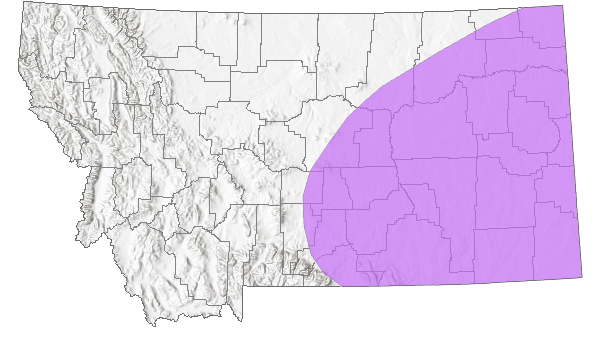
 Native
Native
Range Comments
This species ranges widely across the Great Plains, from Montana and North Dakota southward into Mexico, and east of the Rocky Mountain Range eastward to the western boundaries of Iowa and Missouri. Its distribution occurrence is patchy. In Montana, it has been reported for 6 counties (Hebard 1928, Brooks 1958, Helfer 1971, Capinera and Sechrist 1982, Vickery and Kevan 1985, Pfadt 2002, Capinera et al. 2004, Brust et al. 2008, and Scott 2010).
Observations in Montana Natural Heritage Program Database
Number of Observations: 17
(Click on the following maps and charts to see full sized version)
Map Help and Descriptions
Relative Density
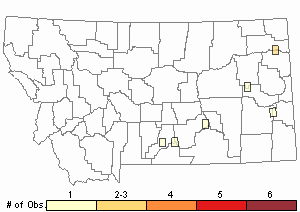
Recency
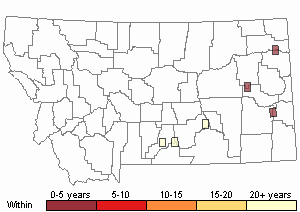
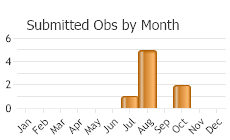
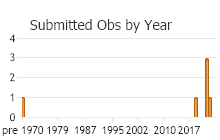
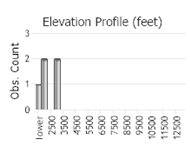 (Observations spanning multiple months or years are excluded from time charts)
(Observations spanning multiple months or years are excluded from time charts)
Habitat
The following comes from Brust et al. (2008), Capinera and Sechrist (1982), Capinera et al. (2004), Pfadt (2002), and Vickery and Kevan (1985). The Plains Lubber Grasshopper inhabits several prairie types, including shortgrass, tallgrass, mixed-grass, and desert grasslands. The species is most abundant in areas of poor soil and frequents areas of weedy vegetation adjacent to fields and roadways. It can sometimes be observed crossing roads or just sitting and basking in the open.
Food Habits
The Plains Lubber Grasshopper is a polyphagous species feeding on a wide variety of grasses and forbs. Its preferred host plants are Sunflowers (
Helianthus). One study in a weedy field revealed that this species consumed 16 species of forbs, 4 species of grasses, and fed readily on insect cadavers. Forbs included
hoary verbena (
Verbena stricta),
prairie coneflower (
Ratibida columnifera),
scarlet globemallow (
Sphaeralcea coccinea), scurfpea, milkvetch,
wavyleaf thistle (
Cirsium undulatum), Indian paintbrush,
western wheatgrass (
Elymus smithii), and ragweed to name a few (Pfadt 2002, Capinera et al. 2004).
Reproductive Characteristics
Egg laying begins in mid-August, and are usually deposited in bare, sandy loam soil. The egg pod is large, measuring 1.75 to 2 inches long and 0.75 inches in diameter. The pod is gourd-shaped and contains 20 to 35 large eggs. When the nymphs hatch in early summer, they pass through 5 instars before reaching the adult stage (Capinera et al. 2004, and Pfadt 2002).
Management
The Plains Lubber is prone to population outbreaks. In its more southern range, it can be a serious pest damaging cotton, beans and rangelands. In northern latitudes, they can become pests to vegetable and flower gardens, but generally the species is a rarity in its occurrence and distribution and generally not considered a pest of any significance (Vickery and Kevan 1985, Pfadt 2002, and Capinera et al. 2004).
Stewardship Responsibility
References
- Literature Cited AboveLegend:
 View Online Publication
View Online Publication Brooks, A.R. 1958. Acridoidea of Southern Alberta, Saskatchewan, and Manitoba (Orthoptera). The Canadian Entomologist (Supplement 9) 90:5-92.
Brooks, A.R. 1958. Acridoidea of Southern Alberta, Saskatchewan, and Manitoba (Orthoptera). The Canadian Entomologist (Supplement 9) 90:5-92. Brust, M.L, W.W. Hoback, and R.J. Wright. 2008. The Grasshoppers of Nebraska. Lincoln, NB: University of Nebraska Extension Service, APHIS.
Brust, M.L, W.W. Hoback, and R.J. Wright. 2008. The Grasshoppers of Nebraska. Lincoln, NB: University of Nebraska Extension Service, APHIS. Capinera, J.L. and T.S. Sechrist. 1982. Grasshoppers of Colorado: Identification, Biology, and Management. Fort Collins, CO: Colorado State University Experiment Station, Bulletin 584S. 161 p.
Capinera, J.L. and T.S. Sechrist. 1982. Grasshoppers of Colorado: Identification, Biology, and Management. Fort Collins, CO: Colorado State University Experiment Station, Bulletin 584S. 161 p. Capinera, J.L., R.D. Scott, and T.J. Walker. 2004. Field Guide to Grasshoppers, Katydids, and Crickets of the United States. Ithaca, NY. Cornell University Press.
Capinera, J.L., R.D. Scott, and T.J. Walker. 2004. Field Guide to Grasshoppers, Katydids, and Crickets of the United States. Ithaca, NY. Cornell University Press. Hebard, M. 1928. The Orthoptera of Montana. Proceedings of the Academy of Natural Sciences of Philadelphia, Vol. 80:211-306.
Hebard, M. 1928. The Orthoptera of Montana. Proceedings of the Academy of Natural Sciences of Philadelphia, Vol. 80:211-306. Helfer, J.R. 1971. How to Know the Grasshoppers, Crickets, Cockroaches, and Their Allies. Revised edition (out of print), Mineola, NY: Dover Publications.
Helfer, J.R. 1971. How to Know the Grasshoppers, Crickets, Cockroaches, and Their Allies. Revised edition (out of print), Mineola, NY: Dover Publications. McDaniel, B. 1987. Grasshoppers of South Dakota. Brookings, SD: South Dakota Agricultural Experiment Station, Bulletin TB 89.
McDaniel, B. 1987. Grasshoppers of South Dakota. Brookings, SD: South Dakota Agricultural Experiment Station, Bulletin TB 89. Otte, Daniel. 1981. The North American Grasshoppers. Volume 1. Acrididae (Gomphocerinae and Acridinae). Harvard University Press. 275 pp.
Otte, Daniel. 1981. The North American Grasshoppers. Volume 1. Acrididae (Gomphocerinae and Acridinae). Harvard University Press. 275 pp. Pfadt, R.E. 2002. Field Guide to Common Western Grasshoppers, 3rd edition. Laramie, WY: Wyoming Agricultural Experiment Station, Bulletin 912, modified by S. Schell and S. Schell for electronic publication. Accessed 19 February 2020. http://www.uwyo.edu/entomology/grasshoppers/field-guide/index.html#fieldguidetoc
Pfadt, R.E. 2002. Field Guide to Common Western Grasshoppers, 3rd edition. Laramie, WY: Wyoming Agricultural Experiment Station, Bulletin 912, modified by S. Schell and S. Schell for electronic publication. Accessed 19 February 2020. http://www.uwyo.edu/entomology/grasshoppers/field-guide/index.html#fieldguidetoc Scott, R.D. 2010. Montana Grasshoppers, Katydids, and Crickets A Pictorial Field Guide to the Orthoptera. MagpieMTGraphics, Billings, MT.
Scott, R.D. 2010. Montana Grasshoppers, Katydids, and Crickets A Pictorial Field Guide to the Orthoptera. MagpieMTGraphics, Billings, MT. Vickery, V. R. and D. K. M. Kevan. 1985. The grasshopper, crickets, and related insects of Canada and adjacent regions. Biosystematics Research Institute, Ottawa, Ontario. Publication Number 1777. 918 pp.
Vickery, V. R. and D. K. M. Kevan. 1985. The grasshopper, crickets, and related insects of Canada and adjacent regions. Biosystematics Research Institute, Ottawa, Ontario. Publication Number 1777. 918 pp.
- Additional ReferencesLegend:
 View Online Publication
View Online Publication
Do you know of a citation we're missing? Anderson, N.L. 1962. Grasshopper-vegetation relationships on Montana grasslands. Ph.D Dissertation. Bozeman, Montana: Montana State University. 73 p.
Anderson, N.L. 1962. Grasshopper-vegetation relationships on Montana grasslands. Ph.D Dissertation. Bozeman, Montana: Montana State University. 73 p. Mussgnug, G.L. 1972. The structure and performance of an adult population of Aulocara elliotti (Thomas) (Orthoptera, Acrididae) near Billings, Montana. M.Sc. Thesis. Bozeman, MT: Montana State University. 97 p.
Mussgnug, G.L. 1972. The structure and performance of an adult population of Aulocara elliotti (Thomas) (Orthoptera, Acrididae) near Billings, Montana. M.Sc. Thesis. Bozeman, MT: Montana State University. 97 p.
- Web Search Engines for Articles on "Plains Lubber Grasshopper"
- Additional Sources of Information Related to "Insects"





